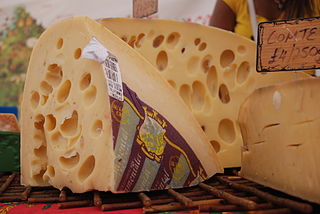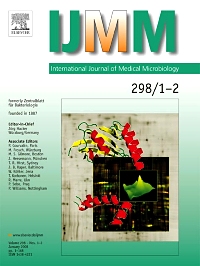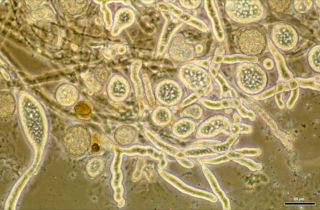
Propionibacterium is a gram-positive, anaerobic, rod-shaped genus of bacteria named for their unique metabolism: They are able to synthesize propionic acid by using unusual transcarboxylase enzymes.

Friedrich August Johannes Loeffler was a German bacteriologist at the University of Greifswald.

Fritz Richard Schaudinn was a German zoologist.
Karl Gottfried Paul Döhle was a German pathologist who was a native of Mühlhausen.
Apocholate citrate agar (ACA) is a selective environment used to isolate Shigella and Salmonella bacteria. The name derives from apocholate and citrate in agar.
Wilhelm Kolle was a German bacteriologist and hygienist. He served as the second director of the Royal Institute for Experimental Therapy, succeeding its founder, the Nobel laureate Paul Ehrlich. He was also the original author, with Heinrich Hetsch, of the famous book Experimental Bacteriology, one of the most authoritative works in microbiology in the first half of the 20th century.

The International Journal of Medical Microbiology, formerly the Zentralblatt für Bakteriologie, is a peer-reviewed medical journal covering research on microbiology published by Elsevier. It was established in 1887 by Friedrich Loeffler. The current editor-in-chief is Sebastian Suerbaum. According to the Journal Citation Reports, the journal has a 2022 impact factor of 4.1.

Sporobolomyces is a genus of fungi in the subdivision Pucciniomycotina. Species produce both yeast states and hyphal states. The latter form teliospores from which auricularioid (tubular and laterally septate) basidia emerge, bearing basidiospores. Yeast colonies are salmon-pink to red. Sporobolomyces species occur worldwide and have been isolated (as yeasts) from a wide variety of substrates. They produce ballistoconidia that are bilaterally symmetrical, they have Coenzyme Q10 or Coenzyme Q10(H2) as their major ubiquinone, they lack xylose in whole-cell hydrolysates, and they cannot ferment sugars. One species, Sporobolomyces salmonicolor, is known to cause disease in humans.
Jeewanu are synthetic chemical particles that possess cell-like structure and seem to have some functional properties; that is, they are a model of primitive cells, or protocells. It was first synthesised by Krishna Bahadur, an Indian chemist and his team in 1963. Using photochemical reaction, they produced coacervates, microscopic cell-like spheres from a mixture of simple organic and inorganic compounds. Bahadur named these particles 'Jeewanu' because they exhibit some of the basic properties of a cell, such as the presence of semipermeable membrane, amino acids, phospholipids and carbohydrates. Further, like living cells, they had several catalytic activities. Jeewanu are cited as models of protocells for the origin of life, and as artificial cells.

František Bubák was a Czech mycologist and phytopathologist.
Mycoplana is a genus of Gram-negative bacteria. The cells are slightly curved or irregularly shaped rods. Initially, the cells can form filaments, which can also be branched. After some time, the filaments break up into irregular rods. Mycoplana is motile by peritrichous flagella.
Bifidobacterium asteroides is a gram-positive, rod-shaped species of bacteria. Various strains of this species have been isolated from the hindguts of honey bees. Prior to 1969, this species was referred to as strains of Bacillus constellatus.
Experimental Bacteriology: in Its Applications to the Diagnosis, Epidemiology, and Immunology of Infectious Diseases is a textbook on bacteriology and infectious diseases. It was one of the most authoritative works in medical microbiology in the first half of the 20th century.
Ichthyochytrium is a fungal genus in the Chytridiales of uncertain familial placement. A monotypic genus, it contains the single rare species Ichthyochytrium vulgare, described from Germany by Marianne Plehn in 1920. A parasite of freshwater fishes, it forms spherical bodies measuring 5–20 µm that have refractive granules. It typically attacks the lung and gills.
Streptomyces finlayi is a bacterium species from the genus of Streptomyces which has been isolated from soil from the plant Trifolium alexandrinum in Russia.
Listeria seeligeri is a Gram-positive, facultatively anaerobic, motile, nonspore-forming, bacillus-shaped species of bacteria. It is not pathogenic. The species was first isolated from plants, soil, and animal feces in Europe, was first proposed in 1983, and is named after Heinz P. R. Seeliger. Seeliger first proposed the species L. ivanovii and L. innocua, and published extensively on members of the genus Listeria.

Ichthyophonus hoferi is a single-celled protist that occupies a key phylogenetic position to understand the origin of animals. It has chitin cell wall, hyphae, and an amoeboid stage. It is a common parasite of marine and freshwater fishes.
Gymnophallidae is a family of trematodes in the order Plagiorchiida.
Cyathocotylidae is a family of trematodes in the order Diplostomida.
Cecidochares eupatorii is a species of tephritid or fruit flies in the genus Cecidochares of the family Tephritidae.







